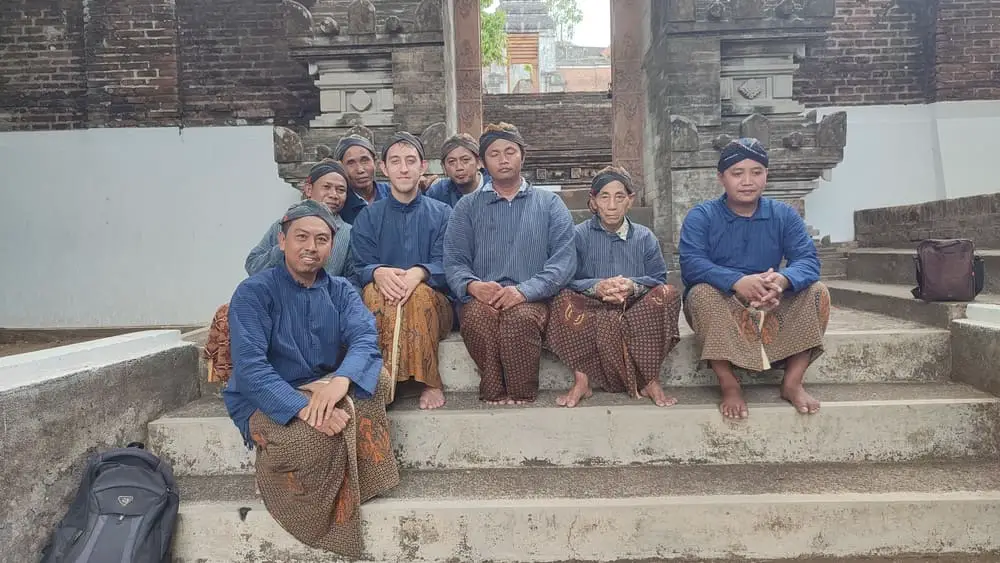Imogiri Royal Cemetery: The Occult Tombs of Java’s Nobility
The island of Java has had multiple empires throughout the ages. Some we know little of, others almost nothing but the one most shrouded in religious mysticism is the Sultanate of Mataram.
The third sultan of Mataram, Sultan Agung the Great, unified most of Java under his rule, vehemently fought against the Dutch colonizers in Batavia (modern-day Jakarta), and most fascinating to me – built a cemetery for himself and his lineage.
The Imogiri Royal Cemetery is a bizarre blend of Islam and Kejawèn (the Javanese animistic beliefs) and an important pilgrimage site of Javanese spirituality and mysticism.
I visited the Royal Tombs of Imogiri and it was an enigmatic experience. Let’s take a closer look.
A Visit to the Imogiri Royal Cemetery
The main thing you need to remember about the Imogiri Cemetery is that it’s a sacred site, very important to the Javanese believers.
The Stairs
Upon entering the Complex, the Masjid will be on your left, a small joglo (a traditional Javanese house) on your right, and in front an impressive and high staircase, leading straight to the top.
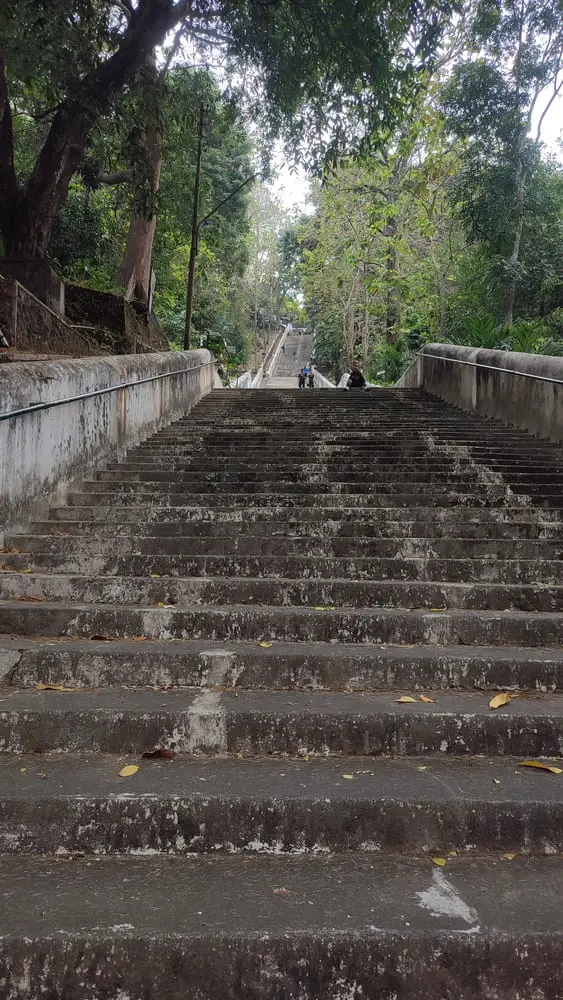
There are exactly 409 steps to Sultan Agung’s Tomb at the very top of the Royal Cemetery. The number is not symbolic, although believers will chant prayers while climbing the stairs.
If you really aren’t fit to climb, ask for a motorcycle taxi to the top. There is a trail close to the stairs and the going rate for this 5-minute service is 20.000 IDR (1.3$).
Tumenggung Endranata the Traitor
The stairs hold a gruesome secret.
Back in 1628/29, Sultan Agung had almost all of Java under the control of his Mataram Sultanate. One thing remained – Batavia, the newly-built Dutch port in the northwest.
He launched an impressive siege of the city, employing both deception and brute force, but to no avail. It was surprising because the Javanese had superior forces and greatly outnumbered the Dutch. As it turned out, a traitor fed the VOC (Dutch East India Company) information.
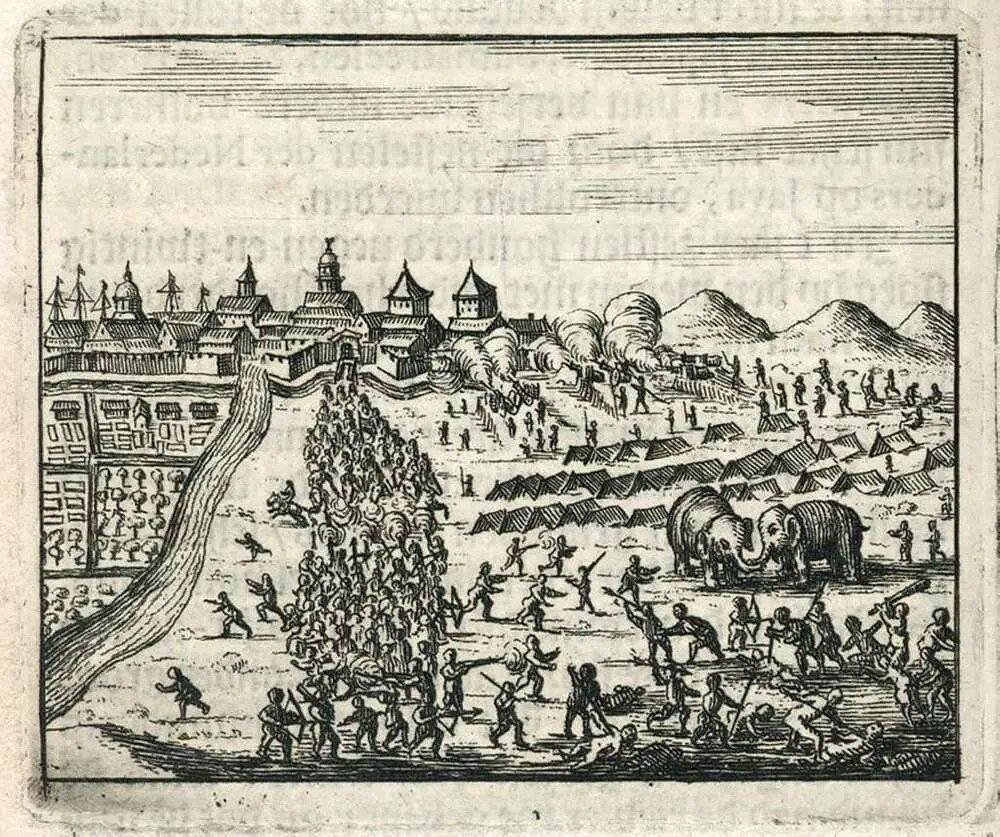
When Sultan Agung learned that his otherwise trusted confidant Tumenggung Endranata was a traitor, he sentenced him to death and mutilated his body.
- Tumenggung’s head was impaled on a stake and left outside Batavia as a warning to the Dutch;
- Tumenggung’s feet were thrown into the sea as a symbol of expulsion from the land of Java;
- Tumenggung’s body was buried under the stairs of the Imogiri Cemetery so that all who walk it step over him.
Another version of the story claims that the traitor’s head was buried under the Main Gate of the Royal Tombs, the torso was buried under the stairs, and the feet were thrown at the bottom of the cemetery pool.
The Jugs of Holy Water
At the entrance to Sultan Agung’s tomb, you’ll notice four large clay jugs inside wooden scaffolding. They have their own names and come from different places:
- Nyai Danumurti from Palembang, South Sumatra;
- Kyai Danumaya from Aceh, North Sumatra;
- Kyai Mendung from the Ottoman Empire (today Turkey);
- Kyai Siyem from Siam (Thailand).
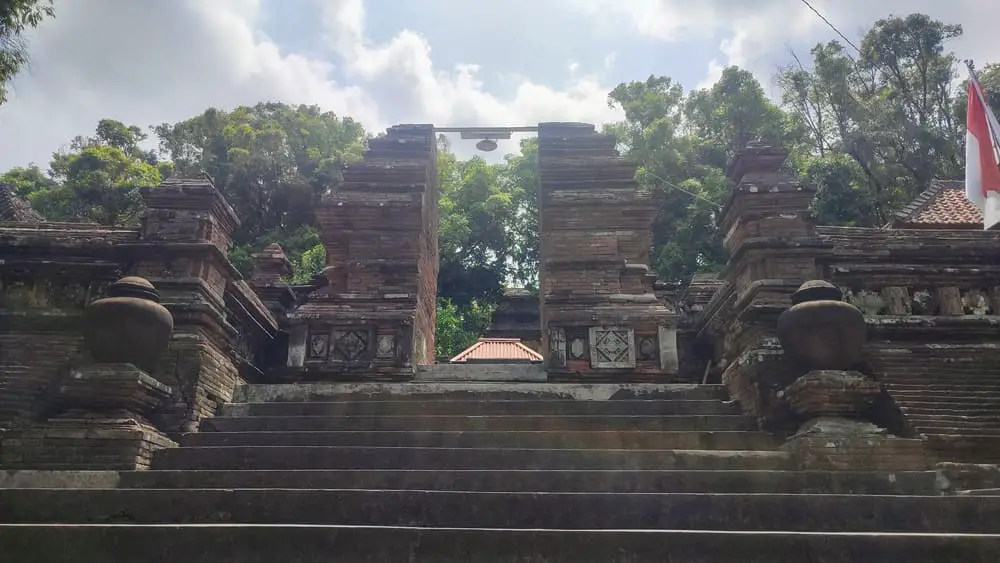
There’s a tradition started by Sultan Agung himself. At the beginning of the Javanese year on Jumat Kliwon when the month of Sura starts (the Javanese calendar is complicated), the jugs are emptied and distributed to residents who believe it to be healing and bring prosperity.
The magic jugs are then refilled and remain untouched until the next year.
I don’t know to what extent one-year-old water is safe, let alone healing…some Javanese traditions are really out there.
The Tomb of Sultan Agung
In stark contrast to the area outside, the uppermost zone of the Royal Cemetery is quiet, even eerie. Loud noises and foul language are strictly forbidden and visitors should treat this part of the visit as a real meeting with Royalty.
To enter the Tomb of Sultan Agung you go behind the building where it’s housed and walk on your knees. Pay the caretaker some small change (2.000 IDR) and enter the tiny stone doorway.
Inside is the Tomb of the greatest Sultan of Mataram. The air is heavy and it’s very hot, owing to the tiny room, the constantly burning candles, and the clothes that trap the heat.
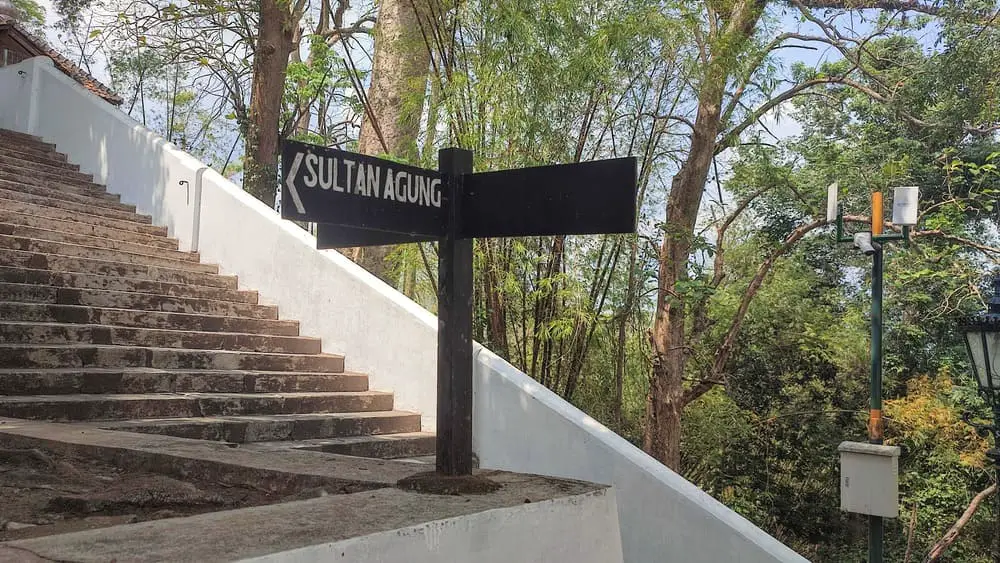
A prayer is initiated by the caretaker inside and you’re welcome to kneel in front of the Tomb and join in. I’m bad with prayers, so I quickly paid my respects and exited.
Right next to the Tomb of Sultan Agung is the tomb of Ratu Kulon, one of the Sultan’s consorts. Usually, men go pray at the Sultan’s tomb and women at the Ratu’s tomb, but both genders are allowed in both tombs.
The Royal Cemeteries of Yogyakarta and Surakarta
On the land under the Tomb of Sultan Agung, are located the two sections designated for the Yogyakarta and Surakarta Royal families.
After Sultan Agung, Mataram slowly lost its power and territories in Java. Over time the Dutch managed to “divide and conquer” different areas of the island, ultimately leading to the dissolution of Mataram and the creation of smaller monarchies, chiefly Yogyakarta Sultanate and Surakarta Sunanate.
They are direct descendants of the Mataram dynasty and have joint ownership of the Imogiri Royal Cemetery.

Thus, the right part (to the east) houses the tombs of Yogyakarta’s Sultans, and the left part (to the west) houses the tombs of Surakarta Sunans.
You can walk the alley in front of the entrances to the actual tombs, but entrance is under the same conditions as the Sultan Agung’s tomb – Javanese clothing, barefoot, no photos, etc.
The decorative styles of the two parts are quite different. The Yogyakarta side is mostly pure white, whereas the Surakarta part’s palette is black with dark green and golden notes.
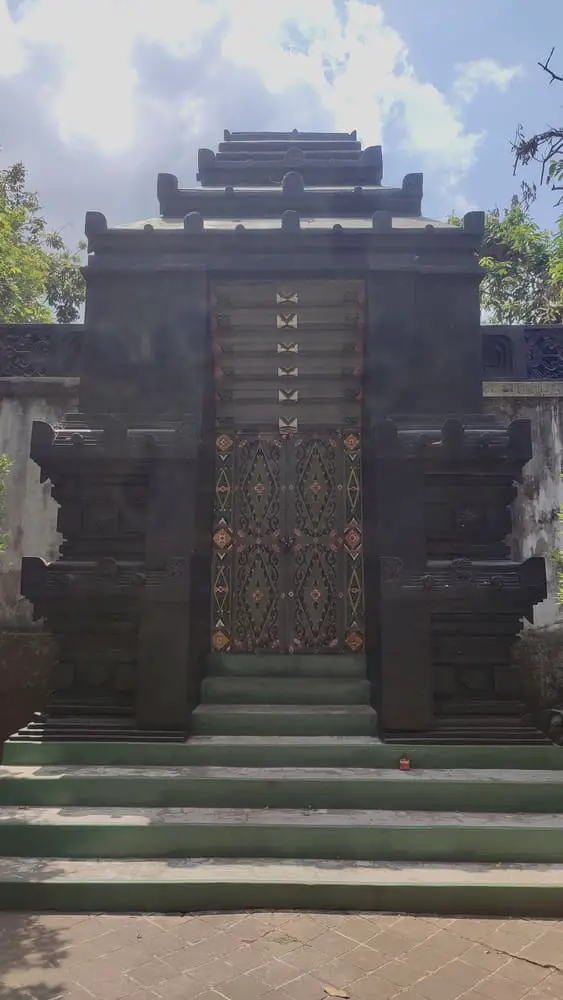
The most notable monarchs buried at Imogiri are Pakubuwono X of Surakarta (1866-1939) and Hamengkubuwono IX of Yogyakarta (1912-1988).
Location and Transport
Imogiri is a small town just 15 km south of Yogyakarta. The Imogiri Royal Cemetery is about 1.5 km from the town, located on a high hill overlooking the surrounding area, right here.
Importance of the location
When Sultan Agung chose the location in 1632, it wasn’t random. Javanese cosmology and geographic alignment are still important concepts in Javanese culture. The Sultan chose this place for the cemetery for two main reasons:
- A straight line runs from Mount Merapi through the Sultan’s Palace at Kota Gede, through the Imogiri Royal Cemetery, and onwards to the ocean, the abode of the Queen of the South Seas (Kanjeng Ratu Kidul);
- It’s on a relatively high hill and the Javanese believe that hills are perfect for cemeteries.
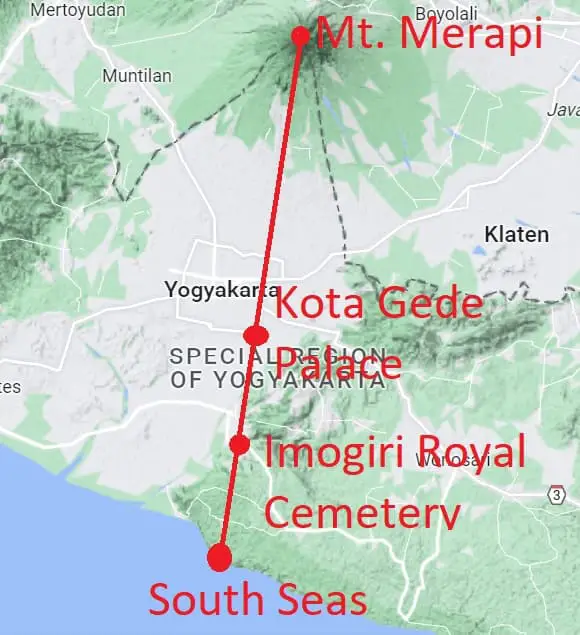
The legend says that Sultan Agung, when deciding where to build the cemetery, threw a handful of sand from Arabia which flew for miles until it landed on this hill near Imogiri. How he and his servants followed the minuscule sand specks is unsurprisingly not discussed.
How to get to the Royal Tombs of Imogiri from Yogyakarta
The easiest way to reach Imogiri is with your own transport. Rent a motorcycle in Yogyakarta and go by yourself.
Message (+62 823 3022 8307) on WhatsApp for the best motorcycle rental that I always use in Yogyakarta. Say you found the number from Simon to get a special offer.
It takes around 30 minutes to reach the Royal Cemetery. You’ll have to pay some negligible sum for parking too (usually 2.000 or 5.000 IDR).
If you can’t drive a scooter, a GoJek or Grab motorcycle taxi is an option. It will cost around 40.000 IDR (2.7$) one way. A car taxi will cost around 100.000 (6.5$) for up to 4 passengers.
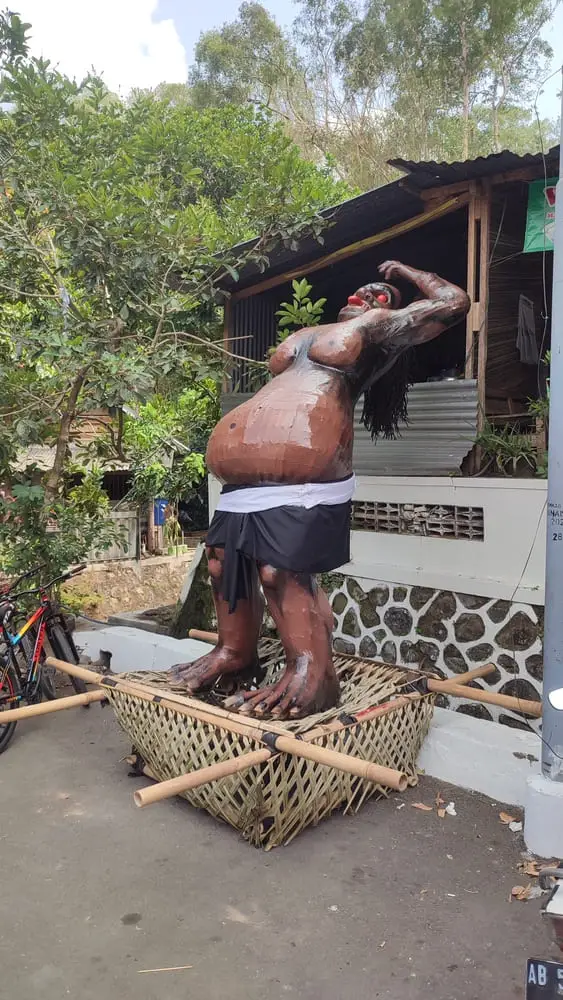
A third option for those looking for some exercise is to rent a bicycle and cycle the 18 or so kilometers to the Royal Cemetery. That’s what I opted for. It took me around 1.5 hours, including a short stop for some Indonesian fried snacks.
Public transport to Imogiri is scarce if at all. There may or may not be a bus from Terminal Giwangan that goes towards Panggang and stops at Imogiri.
Imogiri Royal Cemetery Opening Hours
Imogiri Royal Cemetery is open on Monday and Sunday from 10 AM to 1 PM, and also on Friday from 1 PM to 4 PM (after Friday/Jumaat Muslim prayer).
It’s also open from 10 AM to 1 PM on Shawwal 1 (Eid-al-Fitr) and Shawwal 8 (the first day after 6 days of fasting after the Eid-al-Fitr feast). The Shawwal month is the month right after Ramadan.
It’s also open from 10 AM to 1 PM on Besar 10 from the extremely complicated Javanese Calendar introduced by none other than Sultan Agung. It corresponds to Muharram 10, also known as Ashura, which is an important day of commemoration in Islam.
The Cemetery is closed for the entire month of Ramadan.

Entrance Fee
It is free to enter the Royam Cemetery complex, although donations are encouraged with an unmanned donation box.
Then there’s a donation box for the mosque on site, the Masjid Makam Imogiri.
If you want to enter the Royal Tombs where Sultan Agung was buried, there’s an entrance fee of 15.000 IDR (1$) plus 15.000 IDR more to rent the mandatory Javanese clothes (more info below).
Something I didn’t like was the number of caretakers receiving donations inside the tomb area. One taking donations would be fine, but there were more than 5, just meters apart from each other. Prepare 2.000 IDR notes for each one you pass on your way.
In total, I paid 49.000 IDR (3.25$) for charity and entrance fees.
Dress code
There’s no dress code for the general area of the cemetery.
However, the dress code is very strict when it comes to the sacred areas, including the tombs of sultans past, most notably Sultan Agung.
All sorts of jewelry and gold are strictly forbidden and visitors are required to remove their shoes and go barefoot.
To enter the highest area of the cemetery where the Sultan’s tomb is located, men must wear:
- Beskap: a dark-colored, thick, long-sleeved shirt without a folded collar;
- Jarik: a sarong with batik motifs, wrapped around the waist and covering the legs;
- Blangkon: a headband with deep philosophical significance.

Women on the other hand must wear:
- Kemben: a torso wrap that leaves the shoulders exposed;
- Angkin: A sash tightly wrapping around the abdomen;
- Jarik: the same batik-motifs sarong as for men.
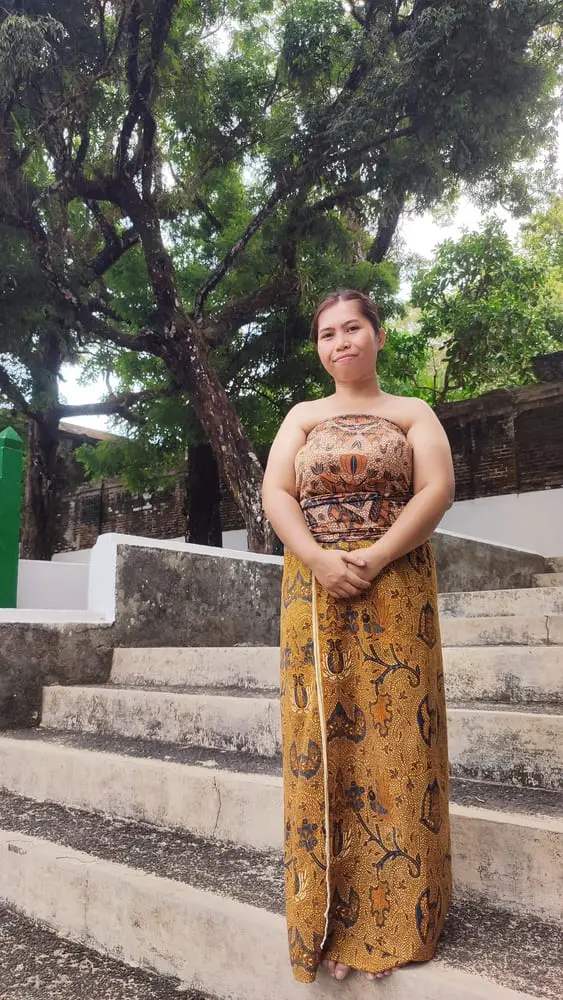
This creates a conflict between the Muslim-mandated female clothing (typically abaya and a hijab) and the revealing Javanese kemben – a representation of aesthetics, elegance, and femininity.
Muslim women who refuse to swap their head cover for a kemben are not allowed entrance.
You don’t need to prepare these clothes before you visit – rent them right in front of the entrance for 15.000 IDR (1$).
Parting Words
I’ve become addicted to the Javanese culture in huge part due to its bizarre blend of religious and spiritual beliefs.
Islam had a very hard time penetrating Javanese society and even to this day a lot of Javanese people are nominally Muslim, but practice a variation mixed with folk beliefs, myths, legends, and syncretic rituals.
The Royal Cemetery at Imogiri is one such place where Javanese traditions are alive and visibly both clash and interweave with Islam. Which is why it’s such an awesome place to visit!
